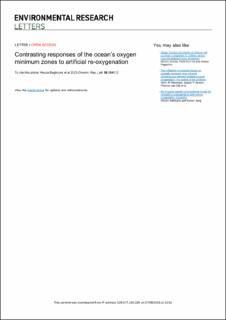| dc.contributor.author | Beghoura, Houda | |
| dc.contributor.author | Gorgues, Thomas | |
| dc.contributor.author | Fransner, Sara Filippa Krusmynta | |
| dc.contributor.author | Auger, Pierre-Amaël | |
| dc.contributor.author | Memery, Laurent | |
| dc.date.accessioned | 2023-10-03T07:01:04Z | |
| dc.date.available | 2023-10-03T07:01:04Z | |
| dc.date.created | 2023-09-22T12:37:58Z | |
| dc.date.issued | 2023 | |
| dc.identifier.issn | 1748-9326 | |
| dc.identifier.uri | https://hdl.handle.net/11250/3093630 | |
| dc.description.abstract | Studies assessing potential measures to counteract the marine deoxygenation attributed to anthropogenic activities have been conducted in a few coastal environments and at regional scale, but not yet on a global scale. One way toward global scale artificial oxygenation would be to use oxygen produced as a by-product from hydrogen-production through electrolysis. The low-carbon footprint renewable production of hydrogen from offshore wind energy offers such a possibility. Here, we assessed the potential of this artificial oxygenation method on a global scale using a coupled physical-biogeochemical numerical model. The anthropogenic oxygen source scenario assumes worldwide adoption of hydrogen, considering demographic changes and the feasibility of offshore wind turbine deployment. Following this scenario, artificial oxygenation had a negligible effect on the overall oxygen inventory (an increase of 0.07%) but showed a reduction in the overall volume of Oxygen Minimum Zones (OMZs) between 1.1% and 2.4%. Despite the decrease in the mean OMZ volume globally, OMZs display distinct and contrasting regional patterns notably due to the oxygen impacts on the nitrogen cycle. Artificial oxygenation can inhibit denitrification resulting in a net gain of nitrate that promotes locally and remotely increased biological productivity and consequent respiration. Increased respiration could ultimately lead to an oxygen loss at and beyond injection sites as in the Tropical Pacific and Indian Ocean and particularly expand the Bay of Bengal OMZ. In contrast, the tropical OMZ shrinkage in the Atlantic Ocean is attributed to oxygen enrichment induced by advective transport into the OMZ, while the absence of denitrification in this area precludes any biochemical feedback effect on oxygen levels. These results suggest that the impacts of artificial oxygenation on oxygen concentrations and ecosystems are highly non-linear. It can produce unexpected regional responses that can occur beyond the injection sites which make them difficult to forecast. | en_US |
| dc.language.iso | eng | en_US |
| dc.publisher | IOP Publishing | en_US |
| dc.rights | Navngivelse 4.0 Internasjonal | * |
| dc.rights.uri | http://creativecommons.org/licenses/by/4.0/deed.no | * |
| dc.title | Contrasting responses of the ocean’s oxygen minimum zones to artificial re-oxygenation | en_US |
| dc.type | Journal article | en_US |
| dc.type | Peer reviewed | en_US |
| dc.description.version | publishedVersion | en_US |
| dc.rights.holder | Copyright 2023 the authors | en_US |
| dc.source.articlenumber | 084012 | en_US |
| cristin.ispublished | true | |
| cristin.fulltext | original | |
| cristin.qualitycode | 2 | |
| dc.identifier.doi | 10.1088/1748-9326/ace0cd | |
| dc.identifier.cristin | 2177908 | |
| dc.source.journal | Environmental Research Letters | en_US |
| dc.identifier.citation | Environmental Research Letters. 2023, 18 (8), 084012. | en_US |
| dc.source.volume | 18 | en_US |
| dc.source.issue | 8 | en_US |

